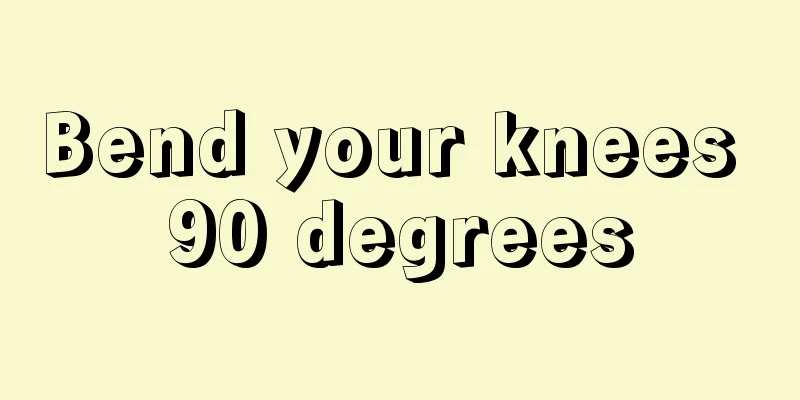Bend your knees 90 degrees

|
Every part of the human body is very important and indispensable, but people will develop some health problems after working too much. The knee is an important part of the human leg joint, but the knee is also prone to problems. For example, the knee may become deformed, which requires additional adjustments to the body. After the knee has been bent and deformed, you should pay attention to rehabilitation training and do recovery training. What are the methods after bending the knee 90 degrees? Rehabilitation exercises for knee flexion angle Specific exercises for knee flexion: (You can practice it yourself at home) Patellar mobilization: The so-called patella, which is commonly known as the kneecap, is a nearly round "sesamoid bone" located directly in front of the knee joint. When the joint is not swollen, you can see the outline of the patella when you stretch your legs naturally on the bed. After injury or surgery, the outline of the patella may be difficult to find due to swelling of the knee joint. The trick is to place both legs side by side at the same angle, and then compare the position of the healthy leg to easily find the patella of the affected leg. (This method is not very useful if both legs are injured or operated on at the same time) The role of the patella is very important for the knee joint, and the movement of the patella when the joint moves is also very complex. I will not introduce it in detail here, and will talk about it in detail later. One point that must be pointed out is that the mobility of the patella determines the flexion and extension angle of the knee joint to a large extent. If the patella cannot move freely, the angle of the knee joint will be greatly restricted and affected! Therefore, before practicing the range of motion of the knee joint, patellar mobilization is usually performed first, so that flexion and extension of the knee joint can achieve better results. It will also be less painful and dangerous. The specific method is as follows: Use the pads of your fingers (pushing with your fingertips will hurt and it is difficult to apply force) to push the edge of the patella, and slowly and forcefully push the patella in four directions, up, down, left and right, to the limit of its position. Do 5-10 times in each direction, and hold for 3-5 seconds when you reach the maximum range of motion. Performing this exercise before knee flexion exercises can help the patella slide during knee flexion. Bedside leg hanging: The so-called bedside is because when we were practicing in the early days in the hospital, we either practiced by the patient's bedside or by the treatment bed. In fact, when I practiced at home, the beds were relatively low, and when my legs were hung down, my feet would touch the ground, so I couldn't practice next to the bed. So you can change it to hanging your legs over the table, that is, you should sit on the table and let your feet off the ground to make it easier to practice. The specific method is: Sit at a table or on the edge of a bed that is high enough. The healthy leg is placed under the injured or operated leg, and the foot is used to hook the ankle of the affected leg from underneath, thus supporting the affected leg with the healthy leg. Completely relax the muscles in the affected leg and put all your weight on the healthy leg. Then, use the strength of the healthy leg to slowly and controlledly lower it down. The lower you lower it, the greater the flexion angle of the knee joint of the affected leg will be. After you feel obvious pain, stop and remain still. After 1-2 minutes, the tissues will adapt and the pain may disappear or decrease. Then you can continue to lower it. This method is suitable for flexion exercises within 0-90°. Because you have your healthy leg protecting you from underneath, you won't be nervous or afraid. This is especially suitable for early flexion angle exercises after injury or surgery, and for warm-up exercises before bending at a larger angle. The key point is that the affected leg must be completely relaxed. The more afraid you are and the more you dare not relax, the more obvious the pain will be and the more difficult it will be to bend it. Sitting on a chair "against the wall": Place the chair facing the wall. The person sits in a chair with the toe of the affected leg against a wall or other fixed object to prevent sliding. After sitting firmly and upright, slowly move your body forward. As your body moves forward, the angle of your knee flexion will increase. Stay still after you feel the pain. After 1-2 minutes, the tissues will adapt and the pain may disappear or decrease. Then move your body forward to the limit. The degree of knee flexion can be measured indirectly by how close the knee is to the wall. Assuming the height of the chair remains unchanged, the smaller the distance between the knee joint and the wall, the greater the flexion angle. This method is suitable for flexion exercises within the range of 90-100°. If the chair is relatively low, when the knee joint hits the wall, the angle can reach about 110°. This method is very safe because the person sits on the chair with his feet on the ground, which is very stable. As long as you don't suddenly push forward with force, the angle will not change too much, and there is basically no danger. (Except when the chair suddenly breaks!) The key point is to sit upright and not lean forward or lift your hips because of pain. Otherwise, it will be impossible to increase the angle or control its progress. It should be noted that this method cannot be used to practice flexion angle after surgery such as tibial plateau fracture or meniscus suture, which prevents the affected leg from bearing weight! Supine leg drop: Lie on your back on the bed, hold the back of your knees with both hands, and keep your thighs perpendicular to the bed. If necessary, you can ask someone else to help fix your thighs and keep them stable. Someone can support the ankle joint of the affected leg to protect it, or you can use one hand to support your heel. After protecting yourself in this way, completely relax the thigh muscles, let the calf droop naturally under the action of gravity, and gradually increase the angle of flexion of the knee joint. After you feel obvious pain, stop and remain still. After 1-2 minutes, the tissue will adapt and the pain may disappear or decrease. At this time, you can release it at a larger angle. This method is suitable for a flexion range of 100-120°. For those with more flexible flexion angles, this method can also be used to practice to an angle of about 130°. In the case of joint adhesion, the weight of the leg cannot increase the angle. You can add load to the ankle joint, but the load must not be too heavy, otherwise the muscles cannot relax and danger may occur easily. Experiment to find the weight that's right for you. It is best not to feel any obvious pain in the first 3-5 minutes, and to allow your calves to relax and droop naturally. The pain starts after 3-5 minutes. The pain in the last 3-5 minutes is so severe that you need to endure it, and it is appropriate to barely hold on for 10-15 minutes. The key point is to keep your thighs fixed and not move. At the same time, learn to relax your muscles and don't stretch your knees to fight the pain. At the same time, keep a good grasp of the weight of the load. The trick is not to use a sandbag, but to tie a bag around your ankles, add things to the bag, if it's light, add more, if it's heavy, take some away, you can easily adjust the weight at any time! |
>>: Abdominal pain after doing plank
Recommend
How to train abdominal muscles?
As more and more people like to eat out, many peo...
What are some ways to exercise your neck muscles?
In some film and television promotional materials...
Are you deceiving me? This action is only for men.
If you have not experienced the anxiety of stayin...
Does skipping rope hurt your joints?
Rope skipping must be a sport that is very famili...
How to train your waistline
Many people want to have a vest line, because hav...
How to exercise the inner chest muscles?
Many men who usually do fitness exercises want to...
Is skipping rope effective for weight loss?
Skipping rope is indeed a very good way to lose w...
What are the exercises to gain weight?
For thin men, they hope to gain some weight after...
What to do if you have pain in the liver area after exercise
Some friends may feel uncomfortable in the liver ...
What are the benefits of outdoor fitness equipment?
What are the benefits of outdoor fitness equipmen...
What is the best way to run on a treadmill?
Nowadays, people's lives are becoming more an...
What are the pros and cons of mountaineering?
Nowadays, many young people and the elderly like ...
How many push-ups can the average person do?
Speaking of push-ups, it is actually a sport that...
What are the benefits of running in the morning?
Running is a very common sport, and it is very si...
How to do chest muscle exercise at home
Chest muscles are what every male friend wants to...









